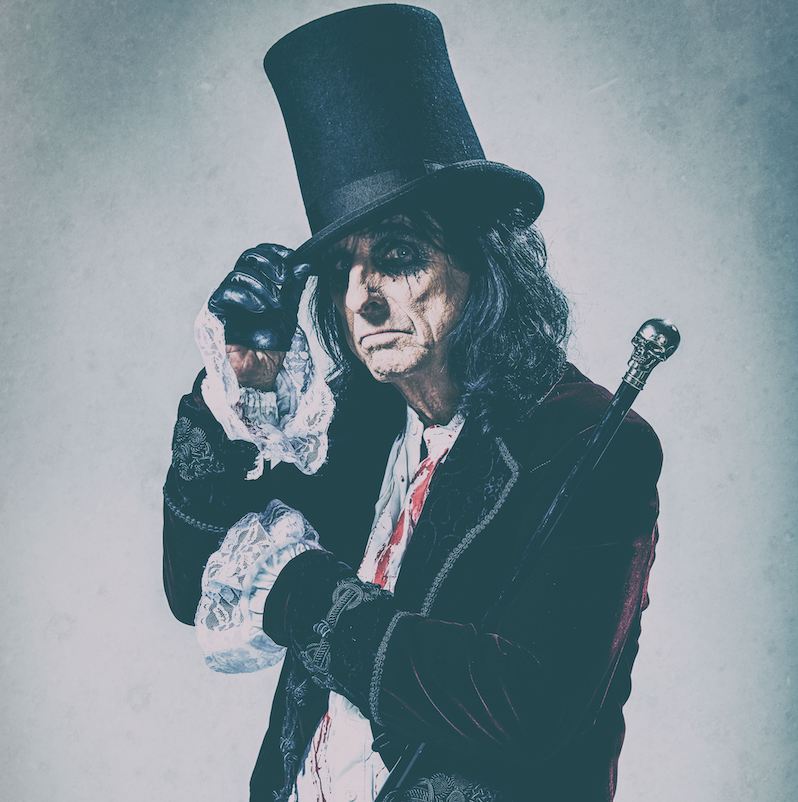On “I Love the Dead,” Alice Cooper achieved peak villainy

Being a lousy person doesn’t take any effort at all, but it’s a lot of work to be an actual villain. There’s a lot of plotting involved. A lot of scheming. Nefarious deeds, unsavory acts, blueprints for mayhem and delusions of grandeur—and they can always be grander. It might require obtaining a deed to a secret lair or perhaps a penthouse, at the very least a balcony to overlook the city in which you plan to commit those misdeeds. There will almost certainly have to be some henchmen involved, and that means having a bookkeeper to file their W-9s and 1099s, unless they’re full-time employees, at which point you’d have to offer benefits—like, for instance, a cut of the bank vault you’re planning on invading, or first pickings at the armory you intend to raid. Maybe you have a cat, and there’s almost certainly a wardrobe full of dark colors and shadowy coats. You have to practice your sinister one-liners and icy grins. You don’t just wake up and start being a villain, you need to plot a course and stick to setting and achieving goals before you have the privilege of actually calling yourself one.
That kind of villainy existed prior to the late ’60s—Lex Luthor, The Joker, actual robber barons—but not in rock ‘n’ roll. Shock rock, however, did—Screamin’ Jay Hawkins and Screaming Lord Sutch used the imagery of vintage horror films and the macabre in their campy stage shows, while Arthur Brown performed with headgear that he very literally set ablaze. But that’s just showmanship, baby. Just because you’re willing to set your head on fire or emerge from a coffin onstage doesn’t mean you’re so committed to the bit that you’ll actually be nourished by the most vile and debaucherous impulses. No, that sort of thing is best left to someone who’s willing to fully step into the role and the bad guy that nobody else will. Someone like Alice Cooper.
In 1968, Detroit singer Vincent Furnier adopted the persona after realizing his band needed a gimmick, and there just happened to be a role available for him to take on. So he and his bandmates put together a vaudevillian stage show wherein their innocuous sounding name became a bait-and-switch for a showman caked in grotesque makeup and donning leather gloves, one who celebrated everything that the hippie movement at the time didn’t: cheap thrills, bad vibes, dark humor and an affinity for the taboo. Sometimes that meant destroying a school, sometimes murder for hire, and at times simply offering a guided tour of the sanatarium that he and his bandmates would build into a legendary signature shtick.
Alice Cooper also had one particular pet topic that made more than a few critics squirm: necrophilia. And he didn’t just write one song about it, but three. The first, “Refrigerator Heaven,” was released in 1970 on Easy Action, which was then later referenced on 1975’s “Cold Ethyl,” a song that Cooper defended in an ongoing argument with syndicated advice columnist Ann Landers in 1979, stating that it was a “harmless song about necrophilia.”
His most famous foray in to romancing the cadaver is inarguably “I Love the Dead,” the closing ballad on 1973’s Billion Dollar Babies. Dramatic, ornate and easily among the creepiest songs in repertoire, the song finds Cooper proclaiming, “I love the dead before they’re cold/The bluing flesh for me to hold.” It’s, naturally, vile and icky, the sound of a man reveling in his chosen role as the heel. It’s also pretty spectacular as a glam rock anthem, the kind of song you might imagine Bowie singing a la “Rock and Roll Suicide,” were it not for the subject matter. (Though Cooper did later cover Ziggy Stardust highlight “Suffragette City” in his sets.)
“I Love the Dead,” and its two counterparts, helped inspire an entire sphere of heavy music and punk, paving a grisly path for later necrophiliac anthems like TSOL’s “Code Blue.” But for Cooper, “I Love the Dead” became an anthem to his villainy—a monument to how far he’d go to ensure his brand of unsavory anthem stooped just a little bit lower than his peers, so much as there were any at the time. Bands like The Misfits and essentially the entire genre of black metal would borrow liberally from Cooper’s shtick, from his look on down to the acts of depravity that he espoused in song.
With “I Love the Dead,” however, Alice Cooper gave it a special touch. Cooper—or I should say Furnier, a real life golf enthusiast and baseball-themed restarauteur, to this day always saves one last twisted thrill for his bloodthirsty audience. “I Love the Dead,” often his set closer, soundtracked his own trip to the guillotine, and in its aftermath, the executioner holds up his bloody, severed head.
When you’re a scoundrel like Cooper’s stage character, you can’t really go out with a whimper. And thus, the cycle of his rise and fall is complete with the swift drop of the blade. Villains—so dramatic.
Support our Site—Subscribe to Our Patreon: Become one of our monthly patrons and help support an independent media resource while gaining access to exclusive content, shirts, playlists, mixtapes and more.
Jeff Terich is the founder and editor of Treble. He's been writing about music for 20 years and has been published at American Songwriter, Bandcamp Daily, Reverb, Spin, Stereogum, uDiscoverMusic, VinylMePlease and some others that he's forgetting right now. He's still not tired of it.

